The Manuscript of Ali Ufkî Bey
The Manuscript of Ali Ufkî Bey
by Burcu Turan
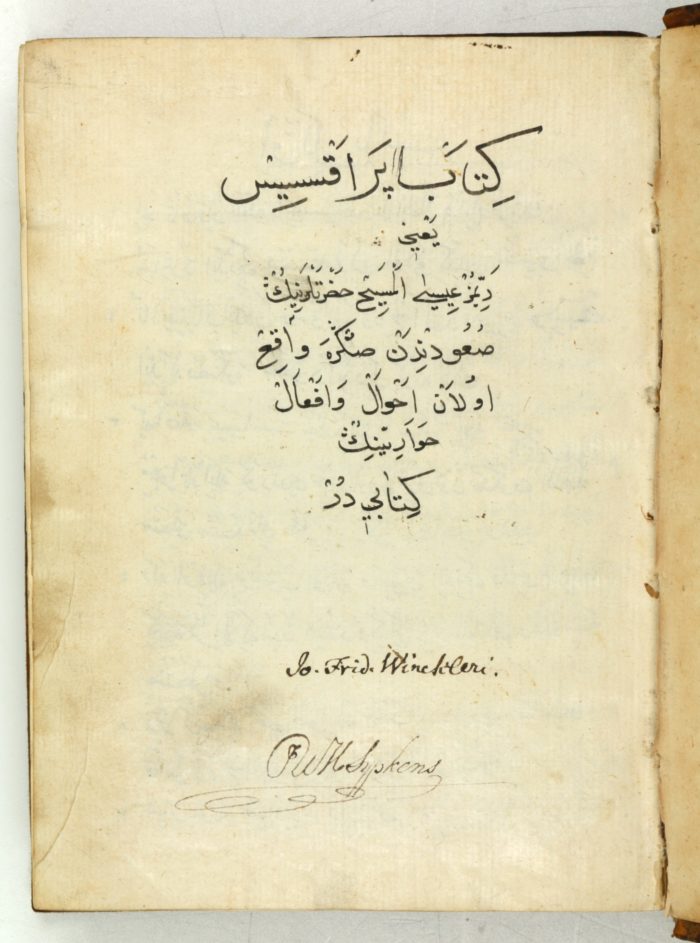
- Author: Ali Ufkî Bey (Wojciech Bobowski – Albertus Bobovinus)
- Title: Ali Bey’in Elyazması (The Manuscript of Ali Beg Bobowski)
- Date: 1665
- Printer: Manuscript
- Pages: 236, in-4
- Language: Ottoman Turkish
- Script: Arabic
- Source: Leiden University Warner Collection (Cod. Or. 390a-e; Cod. Or. 1101a-f; Cod. Or. 1117a) https://digitalcollections.universiteitleiden.nl/
Purpose
The manuscript of Ali Ufkî Bey, which is written between 1662 and 1665, is not the first attempt to translate the Bible into Turkish. In the 16th century, the Psalms were translated by a Sufî scholar called Ahmed b. Mustafa. But the Manuscript of Ali Ufkî Bey is considered as the strongest translation. This manuscript was initiated by Levin Warner, the Dutch Ambassador of the time in Constantinople. Following the completion of the translation process, the manuscripts were sent to the Netherlands.
Formal aspects
The manuscript of Ali Ufkî Bey has 236 pages and it is in Quarto format. It is not illuminated. The original text which Ali Ufkî Bey translated into Turkish is unclear. According to some scholars, it is the “Textus Receptus” prepared by Erasmus based on the Greek New Testament. Considering that Textus Receptus is also the main text from which the German Luther Bible was translated, it is possible to say that it may have been chosen by Dutch Protestant sponsors of the translation project.
The value given to the edition
The Manuscript of Ali Ufkî Bey is important as being the basis of the later printed copies of the Turkish Bible. The Turkish Bible was mainly a Dutch project: It was initiated by Levinus Warner, the Dutch Ambassador of the time, and the project sponsor was a merchant named Laurens von Geer. The manuscripts were taken to the Netherlands once they had been completed and they were subject to review by Prof. Jacobus Golius from the University of Leiden. Nevertheless, the project could not be completed due to the deaths of Warner in 1665, von Geer in 1666, and Prof. Gollus in 1667. The manuscript was kept in the collections of the University of Leiden, until it was rediscovered and printed by the Bible Society with the title “Kitab ül-ahd il atik vel-cedid” (The Old and New Testament) in 1827, in Paris.
Political value
According to Bruce G. Privratsky, whose prominent research on the history of Turkish Bible translations provide detailed information, the initiative to translate the Bible into Turkish was a consequence of the Thirty Years War in Europe, and it occurred as an idea to form an alliance between Muslims and Protestants against Catholic Habsburgs. Earlier, during the Reformation and early Enlightenment period, translating the Bible into Turkish was proposed by humanists Erasmus and Jan A. Comenius. As the Ottoman expansion in the Balkans and in the Mediterranean had caused military confrontations between Muslims and Christians, the purpose of these humanists was to search for a diplomatic approach.
Psalm 23
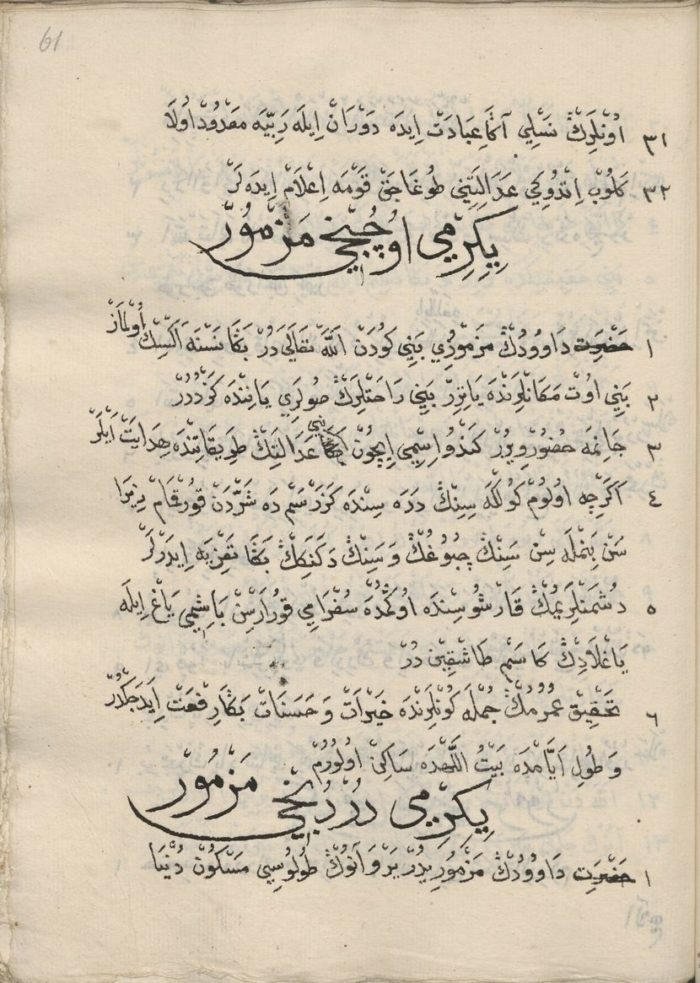
Yiğirmi Üçüncü Mezmûr
1 Dâvudun mezmûrudur Rabb çobanımdır, bana nesne eksik olmaz
2 Beni ot mekânlarına yatırır. Rahat sularının yanında beni gezdirir
3 Canıma huzur verir kendi ismi içün beni doğruluğun yollarında hidâyet eder
4 Eğerçe ölüm gölgesinin deresinde gezsem de şerden korkmam zîra sen benimlesin senin değneğin ve senin asan bana teselli verirler
5 Düşmanlarımın karşısında önümde soframı kurarsın başımı yağ ile yağladan kasem taşkındır
6 Tahkîk ömrümün cümle günlerinde hayret ve hasânet bana mârifet murâfakat edecektir ve tûl-i eyyâmda Rabbin evinde sâkin olurum
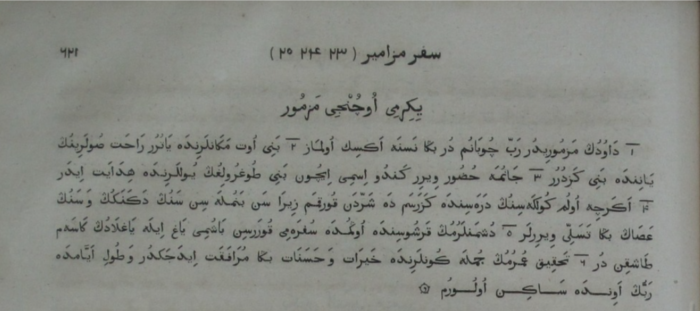
Ottoman Turkish Bible in Karamanlidika
- Autor/Translator: Seraphim Attaliates
- Title: Ψαλτήριον Δαβίδ Πατισσάχ βε Παγαμπερίν τεσπιχατλάριλαν περαπέρ (Psalterion David Padişah ve Peygamberin Tesbihatlarilan Beraber)
- Date: 1810
- Printer: Nikolaos Glykis Printing House (Venice)
- Pages: 292
- Language : Ottoman Turkish
- Script: Karamanlidika (Καραμανλήδικα)
- Source: The Academy of Athens http://editions.academyofathens.gr/epetirides/xmlui/handle/20.500.11855/693
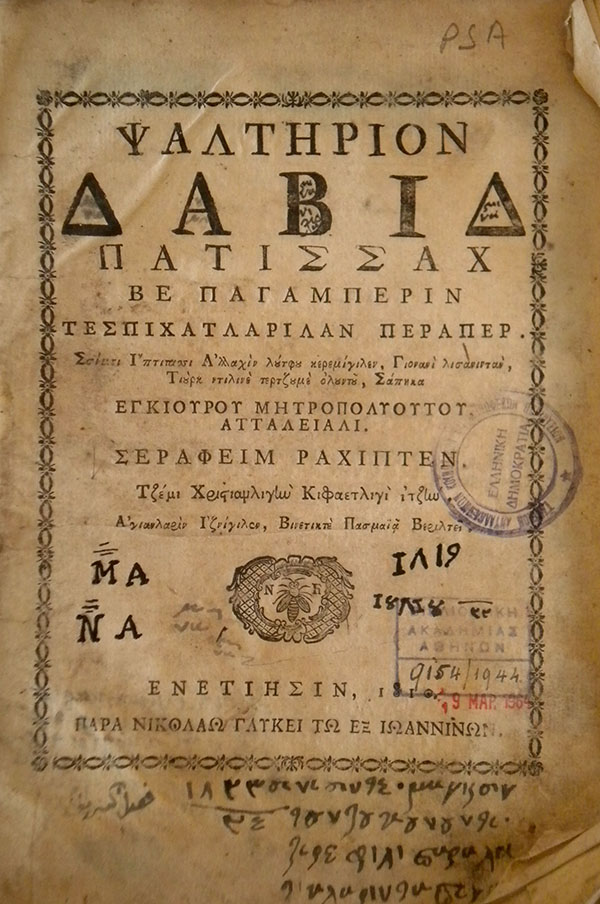
Purpose
Karamanlidika (Greek in script, Turkish in language) was the writing system of Turcophone Orthodox Christians of Anatolia. Beginning from the 17th century in particular, as well as Istanbul and Thessaloniki in the Ottoman Empire, Venice had been an important center for Karamanlidika printing press. Karamanlidika Bible reflects the diverse social and cultural structure of Ottoman society.
Formal aspects
The Psalterion by Seraphim Attaliates has 292 pages. It contains an illustration of David, the text is decorated with vignettes.
The value given to the edition
Seraphim Attalides was a prominent translator and editor in Karamanlidika publishing life in the 18th century. Therefore, his Bible represents a tradition in the Greco-Turkish printing press. According to Stelios Irakleous, his first language was Turkish, then he studied Greek and Latin and studied the religious texts of the Greek Orthodox Church. He made translations from Greek and Latin, and he was also appointed metropolitan of Ankara from 1770 to 1780.
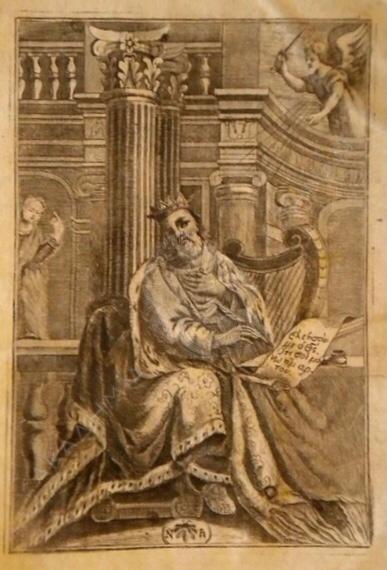
Political value
Regarding the printing houses of non-Muslim communities, it was a prerequisite not to print works with Arabic letters, and at the same time, the works were subject to content control. The fact that they were forbidden to publish works with Arabic letters and that they produced books in their own language/alphabet is important in terms of comprehending the whole multicultural and multilingual cultural atmosphere of the empire.
The reference to David in this Bible is an example of cultural diversity and transitivity between various religious communities: According to Islamic belief, David (Dawud) is a prophet, to whom a book was sent by God. Therefore, David is referred to both as a “king” (padişah) and a “prophet” (peygamber) in the Karamanlidika Bible. The second example of cultural transitivity is the illustration in the book. In Islamic tradition it is not typical to see illustrations with human forms, however, this edition includes an illustration of David.



